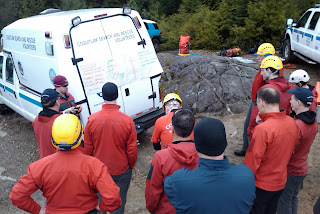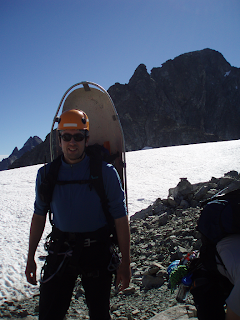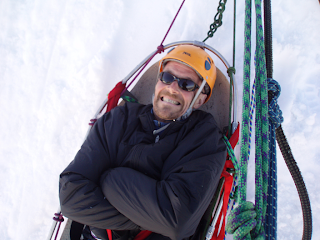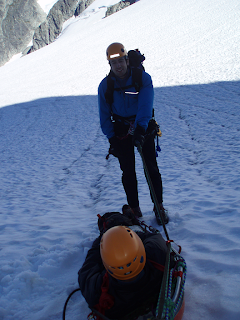Day three of the first aid course is a field day.
Of course, even a field day involves some teaching, and Rollie does a good job using the back of the truck as a whiteboard.
Today we covered spinal immobilization, fracture treatment, splinting, and traction as well as various methods for packaging the subject for stretcher carries, rope rescue extrication, and helicopter evacuation. We have many choices available for carrying a subject: traditional back boards, a device known as a “clamshell” or “scoop” stretcher, a light litter such as the Cascade model 200, or a heavy-duty litter such as the Junkin.
In fact the Cascade stretcher is a pretty amazing device. Built with composite materials, it splits in half so it can be transported by backpack or helicopter. In fact during training I’ve climbed several pitches up to 5.7 carrying half of one. (pictures below from a different training event)
me, getting ready to climb
Steve, beginning the ascent
Steve, beginning the rappel to the glacier
In addition to being light, it cab be used for rope rescue which means that when it assembles it is considered strong enough that it functions as a harness for the subject. We can use it to raise and lower a subject in the horizontal and vertical positions.
Graeme in the stretcher, being lowered vertically
Me, transporting the subject on the glacier
It’s got tie-downs that make it function as a back board so you can immobilize a subject’s spine. It can be fitted with fins to make it easier to slide across snow. If you have to carry it for a long distance, you can attach a wheel to make the job a lot easier, and finally it works well in a helicopter, both strapped across the seats and slung underneath.
The one drawback? If you happen to be a larger person, this is not the stretcher for you.
In fact, if you’re over 6 feet, and about 180 pounds, rescue is definitely not going to be a fun thing for you at all. I’ve put in my time as a subject during training. I’ve been trussed up more ways than I can count, hung off cliffs, lowered into crevasses and flown under helicopters and none of these experiences are in any way enjoyable. Other than the basic discomfort of being tied to what is ultimately a stiff board, and the helplessness that this entails, the equipment is almost never sized to fit my length. This results in my feet being propped on the rail of a stretcher, or hanging over the edge of a back board.
I can only imagine the combination of this discomfort with the pain of an injury.
Well, enough geeking out about gear.







Leave a Reply